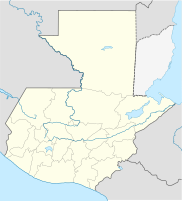San Cristóbal Acasaguastlán
| San Cristóbal Acasaguastlán | ||
|---|---|---|
|
Coordinates: 14 ° 55 ' N , 89 ° 52' W San Cristóbal Acasaguastlán on the map of Guatemala
|
||
| Basic data | ||
| Country | Guatemala | |
| Department | El Progreso | |
| Residents | 6129 (2002) | |
| - in the metropolitan area | 1,846 | |
| Detailed data | ||
| surface | 124 km 2 | |
| Population density | 49 inhabitants / km 2 | |
| height | 250 m | |
| Waters |
Río Motagua Río Uyús |
|
| Time zone | UTC −6 | |
San Cristóbal Acasaguastlán is a town with around 2,000 inhabitants and a municipality in the El Progreso department in Guatemala . It is located 101 km northeast of Guatemala City and 32 km northeast of Guastatoya on the north bank of the Río Motagua at an altitude of 250 m. The important Atlantic highway CA 9 runs through the Motagua valley and also through San Cristóbal Acasaguastlán.
The 124 km² large municipality is located in the very east of El Progreso. It stretches between the Sierra de las Minas in the north and the valley of the Río Motagua in the south. It has a total of around 6,500 inhabitants, the majority of whom live in smaller rural settlements and villages, including Cruz del Valle, Estancia de la Virgen, Manzano Valley, Piedras Blancas and San Luís Buena Vista.
Adjacent municipalities are San Agustín Acasaguastlán in the north and west, and El Jícaro in the south. To the east it borders Usumatlán in the neighboring department of Zacapa .
At San Cristóbal Acasaguastlán was the religious center Acatzavastlán. It was of great importance for Mayan ethnic groups who politically belonged to Copán and Quiriguá (probably Pocomam ). During the colonial period, the area around Acasaguastlán formed from 1551 an administrative district of the same name ( Corregimiento de San Cristóbal Ancazabastlán ), from which the two municipalities of San Cristóbal Acasaguastlán and San Agustín Acasaguastlán emerged. In both places, worth seeing churches in the baroque colonial style remind of the Spanish rule.
San Cristóbal Acasaguastlán and its former rural community El Jícaro belonged to Zacapa until 1908, then to the newly founded Department El Progreso. After its dissolution, it came back to Zacapa from 1920 to 1934, and since then it has been with El Progreso.
See also
Web links
- Official websites (Span.)
